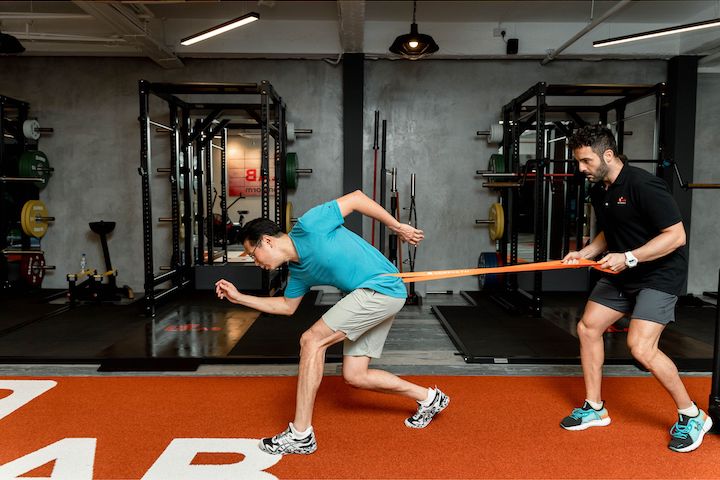

Chronic pain affects millions of people worldwide, originating from a wide variety of injuries and profoundly impacting an individual’s daily functioning, quality of life, and even mental health. Unlike acute pain, which persists temporarily after a minor injury or illness, chronic pain persists for months or even years. So it is crucial that chronic fatigue/pain be managed for a better quality of life. Of course, injury prevention itself helps avoid pain completely.
This is where physical therapy comes in. With the aim of reducing pain levels, restoring function to various body parts, and optimizing overall physical function, physical therapy commonly combines various therapeutic techniques and exercises as part of a personalized treatment plan to provide patients with the tools and knowledge required to live a life of relief through chronic pain management. Let’s take a look at some ways to even prevent chronic pain as well through physical therapy.
Are you looking for ways to stay healthy and injury-free? You’re in luck! Physical therapy can be a great tool to help you keep your body in top condition.
Not only can it help you recover from an injury or the chronic pain following it, it can also help you avoid them in the first place. By strengthening the muscles, increasing flexibility, teaching proper form and technique, maximizing performance, and improving strength, physical therapy can help you stay safe and healthy.
Let’s look at physical therapy’s role in injury prevention.
Strengthening your muscles can be a great way to reduce your risk of injury – and you don’t have to go to the gym to do it! Physical therapy can help you learn how to properly strengthen your muscles with exercises that can be done anywhere.
Having strong muscles can help you maintain proper posture, which helps in injury prevention. Core stability exercises can also help you develop balance and strength in your muscles, which can also help prevent injury.

Physical therapists are trained to provide you with safe and effective exercises that can specifically target the muscles that need to be strengthened. They can also give you guidance on proper form and technique to ensure you’re doing the exercises correctly and safely.
With the help of physical therapy, you can have peace of mind knowing that you’re strengthening the right muscles and doing the exercises correctly.
Increasing flexibility is key to avoiding a ‘painful’ situation down the line. Physical therapists can help you identify weaknesses and improve your balance while increasing your flexibility to help prevent any future injuries.
Here are a few ways physical therapists can help you increase your flexibility for injury prevention:
Physical therapy is essential for increasing flexibility in order to reduce the likelihood of injury. By using the unique combination of stretching, foam rolling, and dynamic stretching, physical therapy can help your body become more flexible and better equipped to handle physical activities.
Your physical therapist will work with you to identify the best exercises for your body and the areas you need to work on. This can help you make the most of your physical therapy and ensure you’re doing the best possible job at preventing injury and improving your flexibility. If you are interested in learning more about the role of physical therapy in keeping you flexible, check out our complete guide on Flexibility.
Whether you’re a professional athlete or a recreational exerciser, your physical therapist can provide guidance on how to safely and effectively perform your chosen activity. This can include reinforcing posture and proper body mechanics, as well as avoiding fatigue.
By teaching proper form and technique, physical therapists can help you maximize your performance and minimize the risk of any future setbacks. They can help you become stronger, faster, and more agile. This can be especially beneficial for athletes, who need to be in peak physical condition to reach their full potential.
With their expertise, physical therapists can help you stay active and exercise safely, reducing your risk of injury. Not only can physical therapists help in injury prevention, but they can also help you improve performance as well.
Additionally, physical therapists can provide the guidance and instruction needed to help you reach your physical fitness goals. With the help of a physical therapist, you can achieve the performance results you desire without putting your body at risk.
Maximizing your performance is possible with the guidance of a physical therapist, helping you hone your body and hone your skills to become a better athlete.

Exploring nutrition, maintaining balance, and understanding your body’s capabilities are key components to reaching your maximum potential. A physical therapist can provide personalized advice on nutrition and diet to help you optimize your performance.
In addition, a physical therapist can provide you with exercises and stretches that will help you maintain balance, coordination, and stability. These exercises are tailored to your individual needs, making them more effective in helping you reach your athletic goals.
With a physical therapist, you can also learn proper form and technique, which can help to maximize your performance. Proper form and technique will help you use the correct muscles and move in the most efficient way, allowing you to perform better and with less risk of injury.
These techniques can also help you increase your speed, power, and agility, giving you the edge you need to succeed.
Strengthening your body and improving your strength can help you reach peak performance, and a physical therapist can help get you there!
By improving balance, developing coordination, and building strength, physical therapists can help you increase your performance, reduce the risk of injury, and improve physical function.
Physical therapists are experts in strength training and can create a tailored plan to help you reach your goals. They can assess your current condition, design a program that suits your needs, and provide guidance and advice on how to safely increase your strength.
With their help, you can build a strong foundation for improved performance, better balance and coordination, and increased injury prevention. Take a deeper dive into how strength is built up with our comprehensive guide to strength training for beneficial physical therapy.
Now that we’ve discussed how physical therapy can help improve strength, let’s shift our focus on how it can enhance body mechanics.

You may be wondering how physical therapy can help with body mechanics, and the answer is simple: by correcting posture and alignment. Such simple things can be an important aspect of injury prevention as well. So, it is essential to take these into account as well.
Physical therapy can help you become aware of your posture, how it affects your body, and how you move. It can also help you develop exercises to maintain proper posture and alignment while you move, so you can reduce the risk of injury.
With any injury, it’s essential to take the right steps to ensure a full recovery – and physical therapy can play an important role in that process.
Physical therapy can help to reduce any kind of pain or arthritis, improve mobility, and get you back to your normal activities. It can also help to prevent re-injury and ensure that you are able to perform at the highest level possible.
Physical therapists use a variety of techniques to help you recover. They may recommend exercises and stretches to help improve your range of motion & strength and provide advice on body mechanics and how you can use your body properly to prevent re-injury.
They also use therapeutic techniques such as massage, heat, and ultrasound to help reduce pain and swelling. Your physical therapist will also teach you how to use assistive devices such as crutches or braces to help you move more safely.
If you have had an injury, it’s important to seek help from a physical therapist to ensure that you make a full recovery. A physical therapist can create a tailored recovery plan to help you reduce pain, improve mobility, get back to your daily activities, and further injury prevention.
Recovering from an injury is only half the battle; now it’s time to arm yourself with the knowledge and tools to ensure you never have to go through that experience again.

Physical therapy is an invaluable tool for injury prevention. By engaging in physical therapy, you can become aware of habits and activities that may lead to injury, and learn ways to modify them. Reducing stress and improving posture, for example, are both key components of physical therapy that help prevent injury.
Physical therapy can also help you strengthen and relax your muscles, as well as increase your flexibility. Increased flexibility and strength can help reduce the risk of injury, as well as make it easier to perform activities of daily living.
By making physical therapy a part of your life, you can develop good habits and improve your overall health and well-being, allowing you to live a more injury-free life.
You can see results or at least improvements from physical therapy in no time at all! Incorporating stretching techniques and rehabilitation exercises into your routine can make all the difference.
You’ll be amazed at how quickly your body responds to the proper healing processes. From improved mobility to increased strength and flexibility, physical therapy can help you get back to your best self in record time.
So don’t wait any longer, start your journey to recovery today with the specialized stretching techniques and rehabilitation exercises that physical therapy offers.
You should always be aware of the risks associated with physical therapy, as it can be a physically demanding form of treatment. To reduce the risk of injury, you should make sure to use proper form and technique when performing exercises and use any equipment safely.
You should also be sure to speak to your physical therapist about any concerns you may have, as they’ll be able to provide guidance about the best way to perform exercises and use any equipment.
You may be wondering if physical therapy is covered by insurance and the answer is yes! Physical therapy services are covered by most health insurance plans, meaning you can reap the cost savings and health benefits of physical therapy without breaking the bank. It’s important to check with your insurance provider to determine the coverage and cost of physical therapy services.
Stretching techniques and prehab exercises are both crucial components of physical therapy. Stretching helps to lengthen muscles, improve flexibility, and decrease the risk of injury.
Prehab exercises concentrate on strengthening muscles, enhancing posture, and restoring balance. Together, these techniques help to decrease the risk of future injury while promoting faster healing.
Look for a physical therapist who can give you a customized treatment plan that includes stretching and prehab exercises to help you get back to feeling your best.
You can take steps to prevent injury in your own home, such as stretching techniques and therapeutic massage. Stretching regularly helps to improve your flexibility & range of motion and helps keep muscles strong and healthy.
Therapeutic massage can help reduce tension and increase blood flow to the affected area. Doing these exercises regularly will help keep your body functioning optimally, ensuring that you stay healthy and injury-free. An ounce of prevention is worth a pound of cure, so take the time to invest in your health now and reap the rewards later.
You’ve taken the first step towards a healthier body and lifestyle by researching the role of physical therapy in injury prevention. With the help of physical therapy, you can strengthen muscles, increase flexibility, and learn proper form and technique.
Maximizing performance, improving strength, and enhancing body mechanics are also benefits of physical therapy. It’s a great way to recover from an injury and help prevent future ones.
With physical therapy, you can take steps to ensure your body is in the best possible condition for your age and activity level. So, don’t hesitate to reach out for help and get on the path to a healthier and happier you.
There are no results matching your search.
Reset